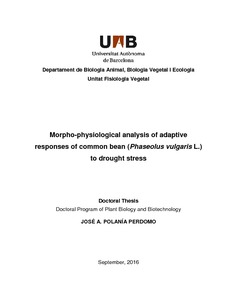Morpho-physiological analysis of adaptive responses of common bean (Phaseolus vulgaris L.) to drought stress. Thesis (Ph.D.)
Common bean (Phaseolus vulgaris L.) is the most important food legume in the diet of poor people in the tropics. This legume is cultivated by small farmers and is usually exposed to unfavorable conditions with minimum use of inputs. Drought and low soil fertility, especially phosphorus (P) and nitrogen (N) deficiencies, are major limitations to bean yield in smallholder systems. Beans can derive part of their required N from the atmosphere through symbiotic nitrogen fixation (SNF). Drought stress severely limits SNF ability of plants. Identification of traits associated with drought resistance contributes to improving the process of designing bean genotypes adapted to these conditions.
Field studies were conducted at the International Center for Tropical Agriculture (CIAT), Palmira, Colombia to determine the relationship between grain yield and different parameters in elite lines selected for drought resistance over the past decade. The selected traits were effective use of water (EUW), canopy biomass, remobilization of photosynthates to grain (pod partitioning index, harvest index and pod harvest index) and SNF ability. Moreover, in field trials we also validated the use of 15N natural abundance in grain tissue to quantify phenotypic differences in SNF ability for its implementation in breeding programs aiming to improve SNF in common bean. Carbon isotope discrimination (CID) was used for estimation of water use efficiency (WUE) and effective use of water (EUW). A set of 36 bean genotypes belonging to the Middle American gene pool were evaluated under field conditions with two levels of water supply (irrigated and rainfed) over two seasons. Additionally, a greenhouse study was conducted at CIAT using plastic cylinders with soil inserted into PVC pipes, to determine the relationship between grain yield and different root parameters such as total root length, fine root production and visual root growth rate in same group of elite lines under drought stress.
Eight bean lines (NCB 280, NCB 226, SEN 56, SCR 2, SCR 16, SMC 141, RCB 593 and BFS 67) were identified as resistant to drought stress. Resistance to terminal drought stress was positively associated with EUW combined with a deeper and vigorous root system, better plant growth, and superior mobilization of photosynthates to pod and seed production, but negatively associated with days to flowering and days to physiological maturity. Based on phenotypic differences in CID, leaf stomatal conductance, canopy biomass and grain yield under drought stress, the tested lines were classified into two groups, water savers and water spenders. These groups also differ in their root characteristics, water spenders with a vigorous and deeper root system and water savers genotypes with a moderate to shallow root system and more presence of fine roots.
We used 15N natural abundance method to compare SNF ability estimated from shoot tissue sampled at mid-pod filling growth stage vs. grain tissue sampled at harvest. The results showed a significant positive correlation between nitrogen derived from the atmosphere (Ndfa), estimated using shoot tissue at mid-pod filling, and Ndfa estimated using grain tissue at harvest. The method showed phenotypic variability in SNF ability under both drought and irrigated conditions. A significant reduction in SNF ability was observed under drought stress. We suggest that the method of estimating Ndfa using grain tissue (Ndfa-G) can be applied in bean breeding programs to improve SNF ability. Using this method of Ndfa-G, we identified four bean lines (RCB 593, SEA 15, NCB 226 and BFS 29) that combine greater SNF ability with higher grain yield under drought stress. These lines could serve as potential parents to further improve SNF ability of common bean. Better SNF ability under drought stress was related with superior presence of thick roots. Superior N uptake from the soil was associated with a large root system with more presence of fine roots. Pod harvest index, grain CID and Ndfa using grain tissue could be a useful selection criterion in breeding programs to select for drought resistance in common bean.

